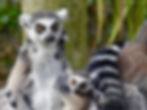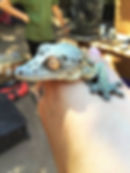Madagascar: Current Conservation Challenges
- Lara Jackson | @lara_wildlife
- Dec 12, 2017
- 4 min read
Madagascar is an island brimming with biodiversity and it is home to a number of iconic species, including the ring-tailed lemur, panther chameleon and the fossa. Having drifted from continental Africa 160 million years ago, the flora and fauna of Madagascar have evolved in complete isolation and as a result, more than 90% of the species are not found anywhere else on earth!
These unparalleled levels of biodiversity and endemism mean that Madagascar is recognised as a biodiversity hotspot and is often referred to as the ‘eighth continent’.
A ring-tailed lemur (Lemur catta) with her young, Lemurs’ Park, Madagascar. © Lara Jackson | @lara_wildlife
However, Madagascar’s incredible wealth of wildlife is under threat. Since humans inhabited the island approximately 2000 years ago, more than 90% of the primary forest has been destroyed and as a result, many species are now on the brink of extinction from habitat loss and fragmentation.
This is even more poignant considering that scientists are still discovering new species at an unprecedented rate! Between 1999 and 2010, more than 615 new species were described, including 61 reptiles and 41 mammals. To this date, at least four more species of mouse lemur have been recognised. What’s more, it is unclear whether the rate of discovery of new species is due to advances in molecular and phylogenetic biology or a result of deforestation forcing the wildlife to disperse into areas they previously would not have inhabited.

The scale of deforestation that has occurred in Madagascar is almost unimaginable, especially given that the island is more than twice the size of the United Kingdom. The primary diver of deforestation is the anthropogenic process of slash-and-burn agriculture (tavy), coupled with the deliberate fires that are used to clear land for cattle pastures; these pressures will only continue to increase with the growing human population.
Madagascar is 2.4 times bigger than the UK!
I was lucky enough to spend six weeks in north-western Madagascar collecting data for my undergraduate dissertation and on the 16-hour journey to my research camp, I was shocked and astounded by the endless miles of barren landscape tinged with exposed rust-red substrate.
A landscape completely devoid of trees for the majority of my 16-hour journey from Antananarivo to my research camp in the Mahamavo forest, Madagascar. © Lara Jackson | @lara_wildlife
Poverty is a stark problem in Madagascar, with more than 80% of the population living under the poverty line (the minimum income needed to secure the basic requirements of life). Subsequently, the main sources of income are derived directly from the environment and the majority of the human population are heavily dependent on natural resources and industries like subsistence farming for survival.
Following on from the threat of deforestation, the increasing access to the forest interior has resulted in a sharp increase in the prevalence of the exotic pet trade, with numerous lemur and reptile species being caught by traffickers and sold on the black market.
A flat-tailed gecko (Uroplatus henkeli), a species at risk from the exotic pet trade. © Lara Jackson | @lara_wildlife

A ring-tailed lemur (Lemur catta) that has been caught and sold into the illegal, exotic pet trade. © Google Images
Furthermore, many species are also at risk from hunting for the bushmeat trade. In some areas of the eastern forest, sifakas have been poached to such an extent that they may soon face extinction in that locality.
Moreover, Madagascar has been affected by political unrest since 2009, meaning that the majority of authoritative panels have broken down and government regulations are no longer enforced. Despite 4.7. million hectares of land being declared protected under the 2010 Durban Vision, a lack of law enforcement and deterrents mean that illegal timber cutting and logging now occurs widely, exacerbating issues like soil degradation and erosion.
These numerous threats have been identified by scientists for years and it has long since been known that to conserve Madagascar’s biodiversity, there needs to be a drastic change in the way local communities utilise the environment and its natural resources. However, herein lies one of the most challenging issues for conservationists…
When the human population is so dependent on the natural resources and more than 80% live in poverty with no other means of generating a livelihood or supporting their families, how do you tell them that they need to stop cutting down trees to sell firewood? Or that they can’t hunt bushmeat to feed their starving children?

Endangered lemur species are increasingly at risk from hunting for the bushmeat trade. © Google Images
There will never be a simple solution, but a balance must be struck between providing resources for the well-being of the human population whilst protecting the remaining habitable areas for the species that naturally occur there.
It is therefore critical that conservation efforts are coupled with social and economic development activities. For example, give the hunter an alternative… teach him how to patrol a protected area; show a subsistence farmer sustainable methods and techniques which will mean he can gain the maximum yield from his land; employ local communities to reforest areas so that both the human and wildlife populations can thrive; educate local school children in the important role that biodiversity plays in natural ecosystems and inspire them to make a change when they grow up…
Most importantly, we need to continue to raise awareness. Thanks primarily to the animated movie Madagascar, ring-tailed lemurs are the most recognised of the 111 or so known species of lemur. But, I guarantee, the majority of people will be unaware that there are only an estimated 2000 individuals left in the wild.
Companies like the WWF have introduced numerous initiatives to restore and maintain Madagascar’s unique biodiversity in harmony with the culture and livelihoods of the local people. They also work closely with governments, scientists, industry and local communities on areas that present the best opportunities to secure the future for the islands people and species.
Such initiatives may be the only way in which we can slow the rate of deforestation and reduce the threats facing the multitude of unique and endemic species that have evolved in Madagascar’s irreplaceable ecosystems.
A golden-brown mouse lemur (Microcebus ravelobensis), one of the species I studied for my dissertation. Photo credit: Michael Darling Lara Jackson | @lara_wildlife
To find out how you can help, follow the link – maybe you could adopt a lemur for Christmas: https://www.worldwildlife.org/places/madagascar
~~~~~~~~~~~~~~~~~~~~~~~~~~~~~~~~~~~~~~~~~~~~~~~~~~~~~~~~~~~~~~~~




